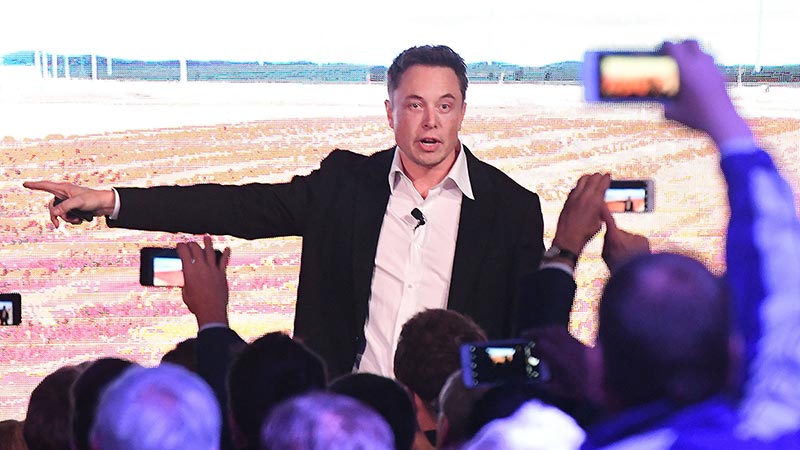Elon Musk reveals new details about Tesla’s global gigafactory plan

Elon Musk launches the Tesla South Australian stationary storage battery in Adelaide last year. Pic: Getty
Tesla boss Elon Musk provided details about the company’s plans for its current and future “gigafactories” at Tesla’s annual shareholder meeting yesterday.
A gigafactory is a huge plant designed to produce lithium-ion batteries by the gigawatt-hour (GWh). A GWh is equivalent to one billion watts for one hour.
Tesla is building the first gigafactory in Nevada, to produce 35 gigawatt-hours of batteries per year needed to power the 500,000 electric cars it plans to build.
Future gigafactories will house battery, powertrain and car production.
ASX producers of metals needed for electric car batteries and components — such as lithium, cobalt, grahite, nickel and copper — are hoping the gigafactories will drive demand.
ASX-listed lithium stocks rallied last month after Tesla signed its first deal with an Australian miner Kidman Resources (ASX:KDR).
Mr Musk discussed Tesla’s plans to construct a gigafactory in China, which will be located in Shanghai.
Tesla will announce details about the Chinese gigafactory as soon as next month.
Tesla will also build a European gigafactory, which may be announced by the end of the year.
Tesla plans to ultimately build between 10 and 12 gigafactories which is part of the company’s plan to reduce production costs for its vehicles.
“Particularly as we try to make cars more and more affordable. It’s getting important to localise production to at least the continent level,” Mr Musk said on Tuesday.
World’s biggest building
The Nevada gigafactory was now about one-third of its planned size and “will be, by far, the biggest building in the world.”
Tesla will continue building the Nevada gigafactory for at least four more years, Musk said.
The company began the project in 2014 amid concerns the global supply of batteries would not be sufficient to meet the demand for its Model 3 sedan, which starts at $US35,000 and is Tesla’s first mass-market vehicle.
Since its founding, Tesla has made an effort to decrease its reliance on third-party suppliers and produce an increasing percentage of its vehicles in-house.
- Bookmark this link for small cap breaking news
- Discuss small cap news in our Facebook group
- Follow us on Facebook or Twitter
- Subscribe to our daily newsletter
Bottlenecks at the Nevada gigafactory have contributed to production delays that have slowed the Model 3’s rollout.
In January, CNBC reported Tesla was making some parts of the batteries by hand that would normally be made by machines, despite concerns about precision and safety.
Tesla called the report “extremely misinformed and misleading” and denied that Model 3 batteries were potentially dangerous.
On Monday, Business Insider reported that Tesla expects up to 40 per cent of the raw materials used in its battery and powertrain production process to be reworked or scrapped before being sent to the California factory where it assembles its vehicles.
Tesla has spent nearly $US150 million on scrap materials this year, according to internal estimates reviewed by Business Insider — a figure the company disputed.
This article first appeared on Business Insider Australia, Australia’s most popular business news website. Read the original article. Follow Business Insider on Facebook or Twitter.
UNLOCK INSIGHTS
Discover the untold stories of emerging ASX stocks.
Daily news and expert analysis, it's free to subscribe.
By proceeding, you confirm you understand that we handle personal information in accordance with our Privacy Policy.








